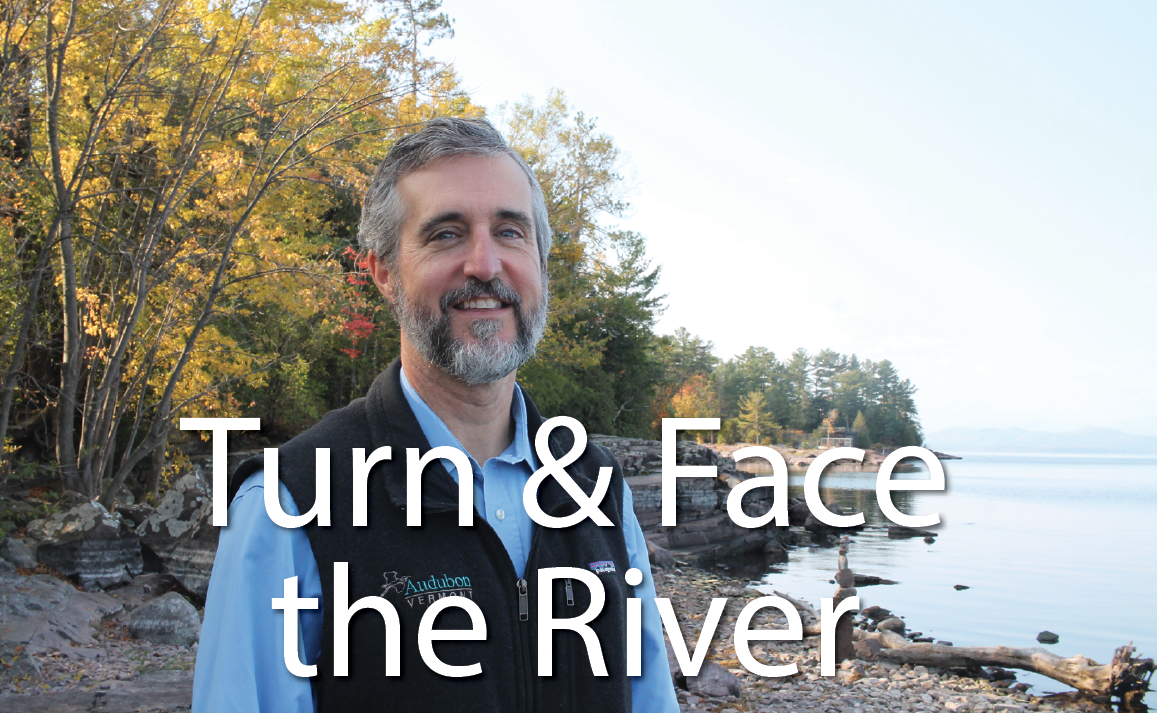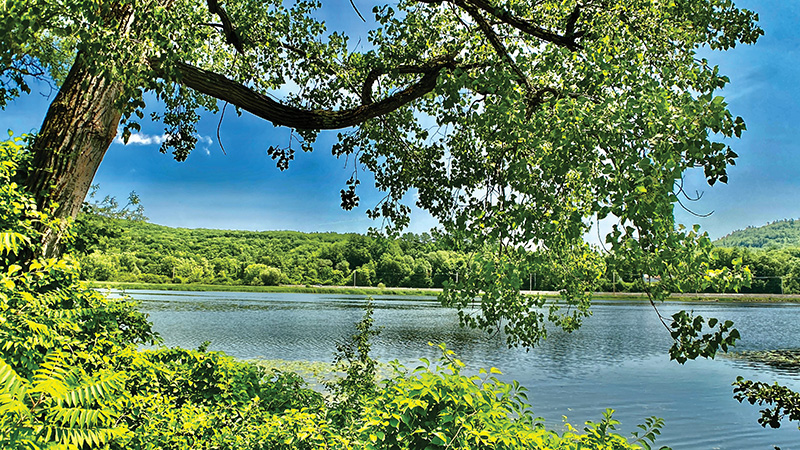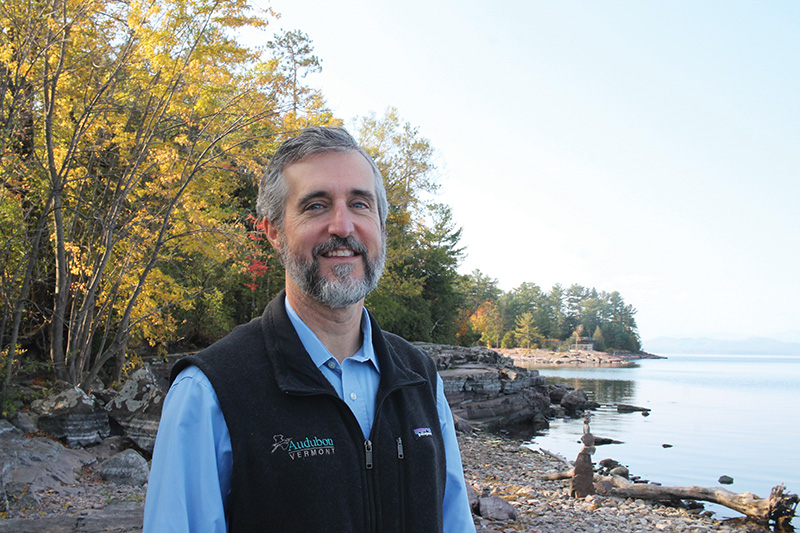
David Mears, the Executive Director of Audubon Vermont.
At a small, hidden spring in the highlands near the Canadian border, the river begins. It trickles over the pebbled gray granite, growing into a creek, joining others in the web of watershed, seizing snowmelt from the pines and ponds and forming a river, a great river, passing through villages and towns and cities in a valley left by the retreating glaciers of the Pleistocene. Though it is only ten thousand years old, a river like this always seems eternal. After all, it flows on and on, apparently able to swallow all our human wrongs and carry them away.
But in a world where a vast human machine controls and dominates the land and riverscape, we have seen how mistaken this impression is. Like many of its neighbors, the Connecticut River has suffered over the past few centuries at the hands of humans. If only we could steer our bureaucratic and technological machinery towards restoration and stewardship, we might live in balance with the watershed and sustain each other—land and people. If calibrated correctly, that vast human machine can do great things.
In early 2021, one of those great things began to emerge, in a small way, as such things often do. The Center for International Management Education (CIME) received a $50,000 grant from the Endeavor Foundation to lay the groundwork for an ecological and stewardship collaborative for the Connecticut River watershed. Partnering with the Connecticut River Conservancy (CRC) and Audubon Vermont, the group hired consultants to develop a case for a river-based umbrella collaborative that is expected to attract millions of dollars over the next decade.
“We’ve got real momentum, there’s a huge amount of interest, and there’s a moment in time where landscape restoration is the way to proceed,” says Andy Fisk, Executive Director of the Connecticut River Conservancy. “Everyone agrees that we face really critical challenges,” agrees David Mears, the Executive Director of Audubon Vermont. “Right now, we have a Swiss-cheese approach to land management; it’s too disconnected, and there is no larger strategy. This is a huge opportunity to make a difference.”
Over the past year, Fisk, Mears, and other partners in the emerging Connecticut River watershed collaborative have met with dozens of federal, state, and local organizations to assess the needs of large and small organizations in the watershed. They have planned for the periodic convening of environmental and cultural entities that go beyond state boundaries and have built the framework of an umbrella collaborative that can distribute funds throughout the watershed. These funds will be used for restoration and stewardship projects and to engage the public understanding of the watershed’s importance.
Fisk’s “small” organization, the Connecticut River Conservancy, is excited to be a part of the process, but as he warns, “It is really important that this collaborative not be the work of one organization.” He continues, citing the 70-year history of the CRC. “Our DNA has always been to build local capacity. For decades we’ve worked with smaller groups, but I’ve hit the maximum capacity to provide resources. There is great land conservation driven by federal dollars, but there is not the same coordination with waterways. We want to catch up.”
Models for this sort of collaboration include the Delaware River Watershed Conservation Collaborative, the Chesapeake Conservation Partnership, and the Lake Champlain Basin Program. “The Delaware is a good model for this,” says Andrew French, Project Leader of the Silvio O. Conte National Fish and Wildlife Refuge. “They’ve got good legislation, a great list of projects—broad-based and solid—with a focus on urban areas.” Having an umbrella collaborative that can engage federal and state agencies—but is not part of them—is a compelling model for this new collaborative. “There are very special places around the country that have seen really good work happen when comparable cooperatives are created,” says Andy Fisk. “When you put a frame around something like the Connecticut River watershed, you’re going to get a lot more work done.”
David Mears agrees. “If you look at this landscape from a bird’s perspective, it doesn’t recognize any of the boundaries that we’ve created,” he says. “But every one of those different lines, every regional and local government, every one of those different land-use organizations has a different agenda. We need a pluralistic approach with many smaller organizations tied to their communities, but we also need an umbrella group that can help smaller organizations and communities engage in the work of restoration in a more strategic way.”
That strategy has begun to take shape, and there are a lot of practical details to take care of in 2022, from staffing plans to governance structure. The watershed collaborative is digging a narrow lane to work in, mainly the organization and coordination of stewardship and restoration efforts at the watershed scale. Another strength of a collaborative is the ability to leverage many stakeholders’ efforts to maximize the collective influence and power. And reaching out to all the potential partners in order to foster a broad sense of engagement is a vital step.
Deb Markowitz, State Director for The Nature Conservancy in Massachusetts, is eager to be one of those partners. “The Nature Conservancy has a history of strong partnerships in the four state Connecticut River watershed,” she says. “We look forward to working together with the Connecticut River Collaborative to advance the restoration and conservation priorities of all our partners in the watershed that benefit both people and nature.”
Along with reaching out to possible affiliates like The Nature Conservancy, the watershed collaborative will continue to refine its policies and functionality to secure the funding required to expand its influence. Andy Fisk’s Connecticut River Conservancy has developed the first core position and expects the rest of their program staff to be indirectly connected to the project. “We will continue to build out the structure organically, refining governance and decision-making, and staffing,” says Fisk. But in the meantime, the umbrella group is taking action to secure funding to advance the work of restoration and stewardship.
That means engaging the Congressional delegation, a process that has already begun in earnest. “There is a lot of public money investment after the pandemic, so we’ll be speaking with delegations from the four states, starting with Senator Patrick Leahy, who has been a long-standing champion of clean water and the environment,” says David Mears. “Over time we will branch out to delegations across the region.” As new federal funding does emerge, federal and state agency decision-makers will need to be invited to the table. Representatives from US Fish and Wildlife have already been included in the preliminary discussions.
Though the region boasts several large-scale authorizations, from the Silvio Conte National Fish and Wildlife Refuge to the Long Island Sound Study, federal funding decisions often leave out small organizations. This collaborative could distribute funds and provide guidance to those community-level volunteers and stakeholders. “We’re incredibly blessed that there is a huge amount of social capital in the watershed, and what we need to do is to put better collaborative structures around that capital,” says Fisk. “It is important to utilize the many small organizations that presently exist. These stewards have a vested interest in coordinated direction that the watershed collaborative can provide.”
The Connecticut River Museum is one of those small stewards. Located on the waterfront along the lower river estuary, the museum offers a spectacular location to engage diverse audiences directly through programs, exhibits, and more. “The formation of a Connecticut River watershed collaborative is history in the making,” says Executive Director Jennifer Carlson. “The museum is excited to support its efforts through community engagement, communications, and education.” Andrew French agrees with this approach. “The bottom line is that what we do for wildlife or restoring the structure and function of these resource areas must be connected to people,” he says. “We’ve got to make visible value relevant to communities, and so we have to focus on education and recreation as well as conservation.”
Another thing that a watershed collaborative can accomplish is to connect the “upland” and “waterway” organizations in more productive ways. “Every ecologist will tell you that watersheds are intimately connected to uplands, but the ways that organizations usually develop, they focus on one or the other without the connection,” says Mears. “Here at Audubon, we’re much more focused on forests and fields, while CRC is more focused on waterways, and so the seeds of the current conversation can be traced back to us trying to bridge that gap.”
The hope is that federal funding opportunities will be matched by private investors and organizations. “Congressional action and politics are uncertain and non-linear,” says Mears. “Success would mean that we have tens of millions of dollars coming into the region matched by other funding. That will be a multi-year effort.”
 The organizers are confident that funding attracted by the watershed collaborative will not take away from current funding of existing programs; any opportunity will need to clearly demonstrate that it is not redundant with an existing program. Including more and different kinds of organizations also means listening to their needs. “We want to bring a range of organizations to the work we are doing,” says Fisk. There’s a real opportunity in libraries and museums to bring them to the work we want to do. There are lots of ways to touch the river.”
The organizers are confident that funding attracted by the watershed collaborative will not take away from current funding of existing programs; any opportunity will need to clearly demonstrate that it is not redundant with an existing program. Including more and different kinds of organizations also means listening to their needs. “We want to bring a range of organizations to the work we are doing,” says Fisk. There’s a real opportunity in libraries and museums to bring them to the work we want to do. There are lots of ways to touch the river.”
That diversity of approach and interest is necessary to meet the challenges of the 21st century. Mears argues that the collaborative needs to engage diverse communities. “Urban communities in particular have been built with their faces turned away from the river,” he says. “We can help them benefit from the river system, to be protected from pollution and flooding, but also to feel more connected to the solutions, which will make them more long-term and sustainable. We can invest in the watershed in ways that create opportunities for access and engagement with the natural world. For people to turn their faces to the river.”
Engaging people is perhaps the most important part of the puzzle. But the ultimate motivation of the plan is improving the watershed itself for both humans and wildlife. “Our work is to make the river healthy and full of life with fins and flippers and pincers and hands and feet,” says Fisk. Mears agrees, putting the case in broader terms. “If you expand ecological thinking to include humans as cultural, social, political beings, then you begin to design solutions that have staying power,” he says. “If we’re going to solve the environmental problems of the next century, we need to draw the circle to include the humans and their communities, because our prosperity and well-being are tied to this watershed.”
The developing collaborative draws a wider circle than any individual organization possibly can, and creates new opportunities for humans, animals, and the environment they share. We don’t often get to witness the early stages of something so important and necessary. It’s as if, deep in the highlands, we have come across a hidden spring, a source of future happiness. Time to follow that current as it grows, joining other small streams, building into a mighty river of purpose, flowing all the way down to the sea.

Image Credit: Getty Images/Samuel Howell.

